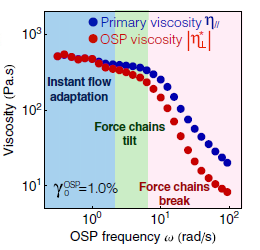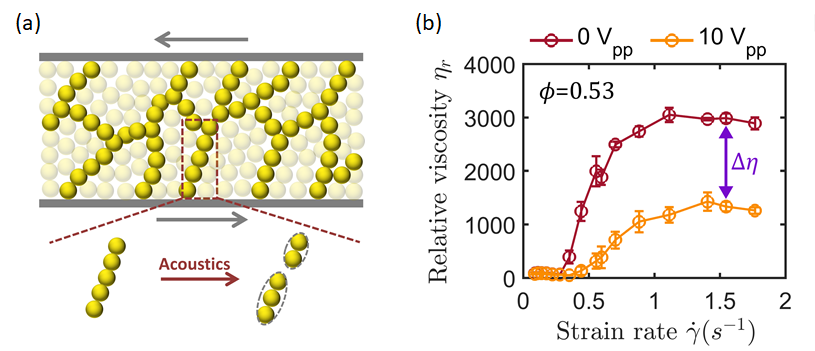Shear thickening fluids like mixtures of cornstarch and water, or oobleck, are not only fun to play with but also have applications ranging from 3D printing to body armor and shock absorption. However, the rapid increase in the viscosity with the shear rate, the very property that makes these suspensions so interesting for industrial applications also leads to jamming and failure of processing equipment. Thus, it is essential to find a method to control and tune the viscosity of these shear thickening suspensions.
Here we discuss the various methods that we are working on to tune the viscosity of these shear thickening suspensions.
Hundreds of youtube videos with millions of views demonstrate people running on a mixture of cornstarch and water. These videos demonstrate the general phenomenon of shear thickening or the rapid increase in the viscosity with increasing shear rate or applied stress on the suspension. This fascinating and yet ubiquitous phenomenon also has various applications ranging from curved surface polishing to soft body armor and shock absorption. However, the very property that makes these suspensions so useful also leads to jamming and failure of processing equipment. Thus it is crucial to tune the viscosity of these shear thickening suspensions.
Previous techniques to tune the suspension viscosity involve changing the particle shape, size, surface roughness or the solvent properties. However, these methods are passive and involve altering the suspension constituents and thus may affect the quality of the end product. Here, we develop a new technique to alter the suspension properties on demand by manipulating the force chains that are responsible for shear thickening.
As stress is applied on these suspensions, the particles are forced closer together and form force chains that are capable of supporting large loads such as the weight of a person walking on top of the surface. These force chains are fragile and easily broken and are constantly rebuilt during steady shear. This fragile nature of the force chains suggest that we can control shear thickening by applying orthogonal perturbations, as shown schematically in figure 1.

Figure 1: Force chains in the suspension without and with the application of OSP flows. As shown in the second panel, the OSP flows break the force chains.
We demonstrate this technique by shearing a silica suspension at a primary strain rate of 0.2s-1, at which the suspension is fully shear thickened, and add in orthogonal superimposed perturbations (OSP). We find the suspension viscosity is initially constant and then decreases by orders of magnitude as the frequency of these perturbations is increased at a fixed strain amplitude (see figure 2).

Figure 2: Variation of the primary viscosity (blue dots) and orthogonal complex viscosity (red dots) as the OSP frequency is increased.
By measuring the suspensions viscosity response to various applied OSP strain amplitudes and frequencies, we find that the viscosity of the suspension depends on a dimensionless number $\dot{\Gamma}$, the ratio of the OSP strain rate to the primary shear rate. The trends in the suspension viscosity can be understood by studying the microstructure of the suspension. When the OSP strain rate is smaller than the driving primary shear rate, the force chains adapt instantaneously to the new shear direction and the suspension viscosity remains the same. At OSP strain rates larger than the primary shear rate, the force chains are unable to adapt and are broken, resulting in a decrease in the suspension viscosity.
However, while this boundary oscillations technique is capable of tuning the viscosity of shear thickening suspensions, it is not practical for many industrial applications. For instance, it is really difficult to shake a large pipe of fluid! Thus, we attempt to find a more easily applicable technique that utilizes the same principle of breaking the force chains in the suspension.
We show that we can utilize acoustic perturbations to actively tune the thickened suspension viscosity. The key principle motivating our work is that nanoscale acoustic disturbances will locally perturb particles and break the force chains responsible for thickening. These acoustic disturbances should generate particle displacements larger than the particle roughness and at time scales faster than the turnover rate for the force chain formations. By attaching a piezoelectric device to the bottom plate of the rheometer, we show that we can use 1MHz acoustic perturbations to tune the suspension viscosity in the shear thickening regime, reducing the viscosity by over 80% at certain primary shear rates. This technique is easily adaptable to various industrial configurations, preventing jamming and clogging of pipes, and allowing for easy flow of thickening suspensions.

Figure 3: The effect of acoustics on the colloidal suspension. (a) A schematic of the expected effect of the acoustic perturbations. (b) Viscosity as a function of strain rate at 0V (maroon line) and 10V (orange line) acoustic perturbations.
Paper on tunable shear thickening : https://www.pnas.org/content/113/39/10774
Paper on acoustic dethickening: https://journals.aps.org/prl/abstract/10.1103/PhysRevLett.123.128001
Cornell chronicle article: http://news.cornell.edu/stories/2019/09/acoustic-energy-harnessed-soften-shear-thickening-fluids
